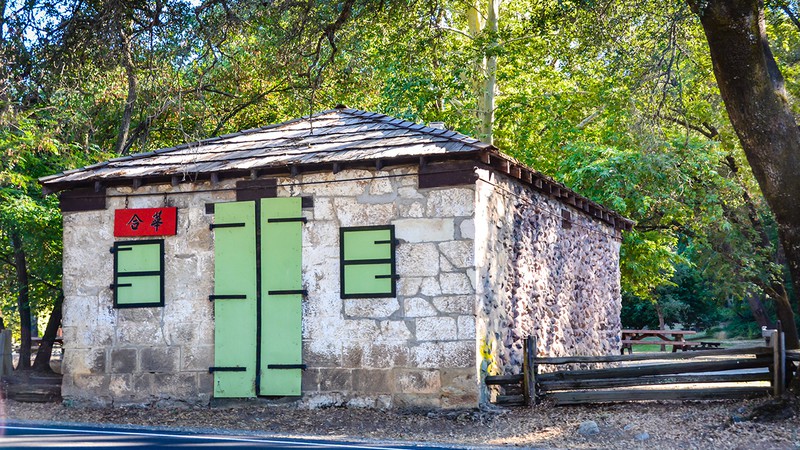
The Man Lee and Wah Hop stores at the Marshall Gold Discovery State Historical Site are all that remains of Coloma’s Chinatown. Sandra Foyt Shutterstock.com
Spanish explorers were possessed by the idea of a New World city made of gold. They never found it, but when this area turned out to be the heart of the mother lode, the powers that used to be named the county in honor of that golden city El Dorado.
The hills are full of old half or wholly abandoned census-designated places where stamp mills once thumped and the great Wheel of Fortune spun like the propeller on a P-26. Money was made, money was lost. It’s still a rich country. The terrain—foothills, mountains, and Lake Tahoe—encourages every sport imaginable, ale and wine trails, and wilderness camping as well as more genteel B&Bing.
The World Rushed In, by J. S. Holiday, is a much-recommended history about what became of this area after the Gold Rush. Even the title is an implicit lament for the spoilage.
Of some use in visualizing the golden days is a gonzo report by a certain Missouri loafer named Clemens—“writing is lazy work, and I was born lazy.” Alias Mark Twain, Clemens was an eyewitness to the mining in Virginia City, Nevada. His inimitable description of the nuts and bolts of hard-rock mining makes Roughing It as indelible a view of the west slope of the Sierra as it is of the Nevada side.
In January 1848, James Marshall was on the South Fork of the American River working on a lumber mill. He was employed by would-be empire-builder John Sutter of Sutter’s Fort, some 50 miles away in Sacramento. When Marshall studied the tailrace, the unit that sluiced the water back to the river after it had turned the mill, he noticed shiny metal debris clinging to the muddy bottom ... and California would never be the same again. This state-changing—nay, world-changing—spot is surrounded by an evocative little brick town called Coloma, with a blacksmith shop and other exhibits, including the Man Lee and Wah Hop stores, the last remnants of Coloma’s once-bustling Chinatown. Pans are available to those who want to crouch on the water’s edge and see if they can make history repeat itself.
Find out more about the Marshall Gold Discovery site on Parks.ca.gov.
Founded in 1938, this nonprofit organization collects artifacts and relics relevant to El Dorado County history. It operates the Fountain & Tallman Museum, located in the Fountain & Tallman Soda Works Building, and supported the establishment of the county-run El Dorado County Historical Museum, located next to the County Fairgrounds. Even when the museums are closed, history buffs can use the site’s interactive map to tour notable spots on the El Dorado Trail.
A glorious place with camping and pedestrian access to the lake, Emerald Bay State Park encompasses Vikingsholm, Lora Josephine Knight’s late 1920s emulation of a Scandinavian manor, built with hand-forged metal fittings and locally quarried stones. Knight thought that this corner of Lake Tahoe, with the lake’s only island and waterfall, resembled the fjords. If Vikingsholm looks familiar, you’re probably remembering it as Michael Corleone’s Nevada home in The Godfather II.
On the subject of stately Tahoe properties, three of them—the Heller, Pope and Baldwin estates—make up the Tallac Historic Site, also known as Valhalla. The nonprofit Tahoe Heritage Foundation partners with the U.S. Forest Service Lake Tahoe Basin Management Unit to offer programs, tours, and cultural events.
For more information, visit TahoeHeritage.org and ValhallaTahoe.com.
“At length they arrived on a very high hill
“With wonder looked down upon old Placerville
“Ike sighed, and he said when his eyes cast down
“‘Betsy, my darling, we’ve got to Hangtown.’”
—“Sweet Betsy from Pike,” The Penguin Book of Folk Ballads of the English Speaking World, Ed by Albert R. Friedman, 1956
The city of Placerville was known as “Hangtown” because of the speedy way it settled its problems with rustlers, rounders, and reivers. The city’s official website has a spirited telling of the origin of the Hangtown Fry, a local dish born from sheer ostentation: eggs and oysters—both monstrously dear in the gold fields. Though the noose was removed from the city’s seal by a vote of the Placerville City Council because it seems to promote the iniquities of lynching, that same council affirmed the town’s historic nickname of Hangtown. But since it’s never a mistake to be sensitive, there’s an easy alternative if anyone wants to find a new name for this artery-choking, cholesterol-oozing special. Surely it should be renamed the “Hangover Fry.”